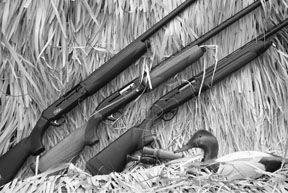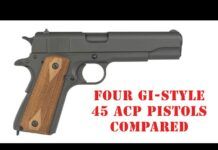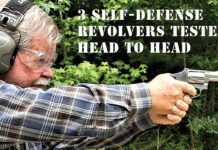
There’s probably no activity tougher on a shotgun than waterfowling. Between the extreme elements (mud, muck, and often uncommonly cold temperatures), the tight confines of blinds, the general roughness of the sport (dogs that won’t sit still, an oversized buddy who knocks something over everytime he turns around), sharp boat edges, action-clogging cattails and Johnson grass, and loads that pack significant punch, a waterfowler’s shotgun takes a beating from trigger to choke tubes.
We thought it was time to examine just how far development in these guns has come, and toward that end, we acquired a trio of 3- and 3.5-inch chambered guns to shoot side by side. From Browning came the relatively new Gold FLD Stalker No. 011118304, a black synthetic-stocked 12-gauge offering that takes 3-inch shells and retails at $981. We chose the brand-spankin’-new Xtrema2 from Beretta, again in black synthetic. This model (No. J391D28) chambers up to 3.5-inch shells and hangs a retail tag of $1,498. For our last choice, we picked the SAS Field from Weatherby, No. SVF1228PGM. We had originally wanted this gun with the synthetic stock, but it was backordered at the time of testing, so we went with a wood-stock model. Retailing at $925 in the wood version (the synthetic is $879), the SAS proved a stellar competitor against the two big “B” brands.
Being May when the testing took place, duck and goose seasons were long closed. Thankfully for us shotgun nuts, sporting clays ranges are in full swing this time of year, so it’s there we took our trio. The shooting gods must have been watching, because it rained during the entire testing day—is there anything more appropriate to testing duck guns?
We also put all three guns in the freezer, loaded with a variety of upland and steel waterfowl loads, and fired them immediately upon removal for function testing. Finally, we performed a point-of-impact test at 40 yards, both from a bench rest (we used the Steady Rest on the MTM shooting bench from Midway USA) and standing, using the National Target Company’s clay shotgun patterning target. Here’s what we found.
This model continues the ongoing morph from the original 2002-year model A391. From an aesthetic standpoint, this new gun is a sleeked up, slimmed down, and thoroughly modernized version of its four-year-old ancestor. This one begs you to take it home just on looks alone.
Starting with the forend, it’s trim without being Tinker-Toy skinny, and it has a pronounced thumb and forehand finger groove on each side of its length, accommodating for shooters who either fully palm the forend or let the thumb ride on the forend top edge with the pointer finger in the groove and parallel to the barrel. A large hand will not find this forend too narrow, as it might a Schnabel forend on an over/under sub-gauge, while a smaller hand will not feel like it’s grasping a small tree. The grooves taper out to the truncated, cone-shaped magazine cap, lending a streamlined, aerodynamic look to the front half of the gun. Of best benefit to the forend are the rubber inserts. They run nearly to the forend’s exposed gas vent on the left and right, with another fair swathing directly on the underside. That they will benefit the waterfowler should be obvious, because in wet conditions, there isn’t anyone who doesn’t need a sure grip on the gun, especially a synthetically stocked one. Giant points for these.
The same rubber inserts appear both at the top of the pistol grip and fully underneath. What’s perhaps more interesting at the pistol grip, though, is its truncated design. Instead of squaring off in a truly (and traditional) pistol-grip design, the grip bottom runs right into the underside of the buttstock itself. We could definitely see an advantage when, say, wearing waders, where the gun can get hung up on the wader top or suspender during dismount and remount.
Up to the pistol grip, the buttstock follows the streamlined design of the forend. Unfortunately, it departs from its clean good looks at the back-end. Here the butt pad looks bulky and oversized. There’s a reason behind that, and that reason is the Beretta Kick-Off System, a pair of hydraulics that reduce felt recoil. Beretta claims that this unit does so by 44 percent over its competitors. That’s fairly astounding, but the Kick-Off gets even more help, as it’s paired with the spring/mass recoil reducer in the gun’s grip. That feature has had its worth tested in Beretta’s competitive guns, where general recoil, muzzle jump, and overall gun jump need to be reduced as much as possible to let such a shooter fire round after round and recover successfully from one shot to another.
That the Kick-Off System is a boon to waterfowlers shooting magnum steel rounds is apparent, but its external pairing with the rest of the gun leaves something to be desired. Its soft-rubber housing is more than an inch wide, and that’s before it has Beretta’s Gel-Tek pad added on. Worse, it’s squared off on the bottom, abruptly ending the bottom slant of the rest of the buttstock. The works is fitted well enough—no overhangs or edges to catch—and, indeed, the top and bottom of the actual pad are rounded and smooth to prevent mount/dismount hang-ups. But we feel the sporty, modern looks are compromised by its design.
The receiver, on the other hand, is totally in keeping with the gun’s sexy design. Rounded over the receiver’s top backside and matched underneath with a radically rounded trigger guard, the receiver top further boasts useful Weaver-mount scope-base grooves, perfect if you want to add on a slug barrel for deer season or take this gun directly to the turkey woods after snow goose season closes. The only thing some of our testers didn’t like was the safety-button design and placement. It is small, possibly a hard find for a gloved hand, and to the front right of the trigger guard rather than behind. It proved an awkward reach for smaller hands, sometimes even requiring a repositioning of the hand to effectively and correctly get back to the trigger.
Finally, the barrel (in matte blue, as is the receiver and magazine cap), sports a widely-spaced vent rib (easy to clean) and comes with an integrated, green fiber-optic front sight. There is no mid-rib bead. All metal is treated with Beretta’s Aqua anti-corrosive treatment that saltwater hunters will appreciate.
We were anxious to try this one, as its external features looked like they’d prove functional rather than just so much space-age design covering the same old thing. Using a combination of Winchester Super Sporting 2.75-inch 12-gauge 1 1/8-ounce loads and Remington Nitro Express 2.75-inch 1 1/8-ounce shells, Beretta claims this Xtrema2 will cycle loads down to 1-ounce 3.25 dram equivalent. Sure enough, shooting Winchester’s Featherlight loads often resulted in a failure to eject the empty casing or a failure to feed up the next round. But beyond that, we experienced no mechanical failures. The point-of-impact test proved to be centered—but that was from the bench. Put in motion, this gun disappointed our testers.
The Xtrema2 is long at 14.66 inches length of pull and 50.4-inch overall length with the 28-inch barrel. Part of this is due to the longer receiver (9.25 inches) needed for the 3.5-inch shells. Beretta offers half-inch stock spacers that can add length, but no spacers or shims are included on the gun that can reduce it. Total weight empty was 7.5 pounds. The gun does mount cleanly when we wore minimal clothing—we had a straight view to the bead, no ramping—but as this gun has no cast-off, over heavy clothing, it had us looking down the left side of the barrel.
Encumbered by too much length, this gun’s balance left a lot to be desired. We found it too front heavy, with that weight seemingly balanced in front of the fore hand, rather than in it. While this actually enhanced the swing in a fast-crossing overhead, it felt like we were swinging a 2-by-4 on nearly every other target presentation we came across. If you weren’t in line with the target immediately upon mounting the gun, you simply weren’t going to get there. This is not a gun that we could correct while swinging on a target. This poor handling was exacerbated when attempting to mount and shoot from a layout position on the ground, where our ability to swing was already compromised by lack of flexibility at the waist.
Even worse than the handling was the bolt-close button. It is incredibly stiff in depression, so much so that it often took two thumbs to mash down and successfully close the bolt. That’s completely unacceptable in a waterfowling gun, where quick reloads are the norm when the action is hot, and where gloves already cut down sensitivity and function.
What we did like about the gun was its magazine cut-off. Located on the left side of the receiver, it easily operated with one hand and handily snapped the receiver shut; the bolt-close button should have operated this easily. We also liked the integrated Tru-Glo sight, welded to the rib. These should be SOP on any shotgun these days, their benefits over the white or brass bead of yesterday too numerous to mention here. However, we’d like to see it available with interchangeable color pins. Trigger pull was crisp and hunting safe at 6.1 pounds, measured with an RCBS Trigger Pull Scale supplied by Midway USA.
We did see the benefit of the Kick-Off System. Muzzle rise was minimal between shots, even with heavy loads, and we never felt like we were getting a bust to the chops. But we’re not sure that the added $400 justifies this feature.
Heavy clothing sucks up a lot of recoil, as does adrenaline, and because the gun already has other recoil-reducing features, this seems a pretty steep price to knock off more punch, in our view. We think we’d rather have better gun fit and balance and that $400 in our pocket than the other way around.
[PDFCAP(2)]
This gun fared better than the Beretta, though when we initially took it out of the box, we didn’t think it would. Just dry mounting next to the Beretta, the Beretta felt better, but in actual shooting conditions, the 8-pound Browning proved the more manageable gun.
The Gold FLD Stalker, which squares off the back of the receiver of the other Gold models and harkens some resemblance to the old A5, felt a bit front heavy, too, but the weight was more balanced in the front hand. This makes the gun more controllable and therefore more accurate. Overall length with the 28-inch barrel was 48.3 inches. We connected on far more targets with this gun than we did with the Beretta, despite the fact that both sport the same LOP. Trigger pull was a bit leaden at 7.25 pounds, but not atrocious.
Browning advertises that because of its Active Valve gas system, which works to ensure a better range of functionability over a range of ammo, that its Gold models will shoot light 1-ounce target loads in the 3-inch-chambered models (the gun is not offered with a 3.5-inch chamber). We found that claim to be mostly true; we had intermittent trouble with Winchester’s Featherlight loads, though we suppose those can be characterized as “ultra”-light loads rather than just “light.” As with the Beretta, sometimes these ejected, sometimes not, sometimes the gun fed up the next shell, sometimes not. However, since none of these guns are intended for target shooting and no waterfowler in his right mind would shoot loads this light, this really isn’t a detracting factor, and we’ll give Browning a passing grade on this.
It also passed the freezer-to-fire test, cycling though the mix of loads without flaw.
This gun has several outstanding features to it and only a couple that got a thumbs-down. In general, this gun handles well. It’s not as well balanced as a custom-made Holland & Holland, but you wouldn’t expect that. It is well-balanced for what it is (and for its weight, the heaviest in the group). Some decisive handling will be the norm (i.e., you’re not going to just float this one into position, you’re going to have to push it where you want it to go), but it doesn’t have to be man-handled. It swung well and instinctively on aggressive, fast targets (teal anyone?), yet still allowed for some control and precision on other presentations, such as battues and soft dropping incomers. You won’t get surgical precision, but it’s more agile than the Beretta. We also didn’t notice much muzzle rise between shots, though it had more than the Beretta.
The FLD sucked up recoil from the heavy target loads well, in part thanks to the weight and partly due to the nice thick recoil pad. Downsides to this pad, though, were its sharp heel and toe and its too-tacky soft-rubber construction. Traditional, but it often caught and stuck on clothing while mounting. And since Browning doesn’t offer a shim kit to adjust LOP/drop/cast, this will be a problem for a lot of average-sized sportsmen, especially layered up for the hunt. Finding a gunsmith who can competently alter a synthetic stock to a correct length can be tough, so other than swapping out the recoil pad to something slightly slimmer, buyers will be stuck with this gun as is.
The cross-bolt safety is one of our favorite features on this gun. It’s big without being in the way (easy to find even with a thick glove on); takes a positive push from either side to engage/disengage (you’re not accidentally going to activate it either way); and sits at the rear of the trigger guard, where we find it more practical and safer to keep our trigger finger before we move to the trigger. This safety is also reversible for left-handers.
The FLD includes a magazine cut-off. While not as sleek or integral as Beretta’s, it’s easy to operate with a gloved hand, and its forward placement on the front left side of the receiver isn’t in anyone’s way, whether shooting left-handed or right.
But perhaps the best feature of all is Browning’s spectacular speed-feed design. There is nothing faster to reload when ducks/geese/targets are pouring in. Run the gun dry, and all you have to do is shove a shell into the magazine. Voil! The shell auto-feeds up into the chamber. This is far more convenient and quicker than trying to juggle a shell into the receiver slot and hit the button. In fact, you can quick-load and shoot singles faster than you can reload the whole magazine to fire. We absolutely love this feature on a waterfowl gun.
We’d take the speed-feed over just about any other option, but it doesn’t make the Browning FLD Stalker ideal. We found its synthetic stock to be slick, and the “checkering” didn’t really help much. It also lacks a fiber-optic sight, and the white bead is just too hard to see on overcast days. Fiber-optic sets, like the Wingbuster from Hi-Viz that Browning also markets under its name, usually run no more than $30 or so, and when the gun retails for $981, it would seem a simple and low-cost item to include.
[PDFCAP(3)]
A member of our test team owns an SAS, and the gun has more than held up its end of the deal when it comes to real-life wear and tear. It has been dropped in the mud, soaked to the bore, trampled on by over-anxious retrievers, and it repeatedly has taken some hard knocks and never failed. Ten gold stars right there.
Nonetheless, we took it to the sporting clays course for a side-by-side-by-side comparison with the other two. Wow, what a difference a test like that can make.
At 7 pounds, this gun weighs the least of the three, but it is by far the best balanced. Its weight sits squarely between the hands, with just a tad to the front. That, of course, translated directly to greater control. It didn’t matter what was thrown, screamers to duffers, aerials to ground cruisers and droppers, this gun was the most nimble of the three, we thought. And while it sported a bit more muzzle rise than the other two, it didn’t seem to affect shot-to-shot transition. This is due, in part, to Weatherby’s Internal Dampening System, which cuts down significantly on the felt recoil resulting from the impact of the bolt at the back of the receiver during cycling. We can verify that the system works from using steel loads during duck season. Sure, there’s more kick with 3-inch shells (Weatherby does not make this gun in a 3.5-inch version), but they didn’t leave us feeling battered and didn’t interrupt our swing and target acquisition. We liked the clean break of the 6.1-pound trigger pull.
This gun matches the Browning in LOP at 14.25 inches, and is 0.125 inch shorter in overall length. The SAS is thicker through the belly of the forend and around the wrist than the other two, but not to a degree that those of us with smaller hands had to fish around for a comfortable hand position. Weatherby does include a shim-spacer kit to alter the cast on/off, drop, and LOP, an appreciated feature. Fit and finish are fine, and the entire gun is traditionally styled—not a lot of details, but not unpleasant to look at either. You do tend to get a pretty nice piece of oil-finished wood on the Weatherby, despite holding a more economical price tag than other wood-stocked autos in its class.
Like the others, the Weatherby sports a magazine cut-off, here a serrated dial on the lower right edge of the receiver. It’s easy to activate, though a bit small and buried for a gloved hand. We could do without the brass bead sight and go with a fiber optic, which Weatherby does supply on its Breakup and Shadow Grass synthetic versions (the black synthetic also gets the brass bead treatment). Finally, we encountered the same problem with the Winchester Featherlight shells that we had with the others, really a non-issue for waterfowlers but worth mentioning in the overall scheme of testing evaluation.
Gun Tests Recommends
• Beretta Xtrema2 12 Gauge 3.5-inch No. J391D28, $1498. Don’t Buy. No question, the Beretta offers an attractive modern appearance and a bevy of shooter-friendly features, including its advanced recoil-reduction system, fiber-optic sight, rubber grip inserts, and integral magazine cut-off. But the gun’s weight distribution is too far forward for any but the biggest shooter to handle. Overall, it’s awkward to mount over heavy clothing, so acquiring targets at all but the simplest skeet angles and heights will be a chore. This gun simply isn’t flexible enough, and paired with the difficulty we had using the bolt-close button, verges on lacking in the functionality department, as well.
Further hampering a recommendation of this gun is its pricing. Its astounding $1,485 tag is due mostly to the Kick-Off System. We don’t think it’s worth it. For all-around waterfowling, this one doesn’t make the grade.
• Browning Gold FLD Stalker 12 Gauge, $981. Conditional Buy. The FLD handles better than the Beretta, but not as well as the Weatherby, in our estimation. At the same time, shooters will be restricted with what they can do about fit because synthetics are difficult to alter correctly, and this gun does not come with a shim or spacer adjustment kit. The stock is also a slick to handle for a synthetic stock, though wearing gloves reduces that factor. We recommend anybody who buys this gun to swap out the equipped butt pad with something rounded on the ends and smoother; Browning’s pad hangs on clothing too much, in our opinion.
What wins big for the Browning is its speed-feed feature. If you’re one of those lucky duck shooters who’s in the flights time and again, then you simply won’t consider any other semi-automatic. Set the blocks out, hit the first flight as it comes in, reload to catch the stragglers on the way out, and you are done and limited out before anyone else has a chance to reach for their come-back call. This gun sits squarely in the middle of today’s ever-increasing prices for semi-automatic hunting shotguns, but this feature justifies the nearly four figures you’ll shell out for it.
• Weatherby SAS Field 12 Gauge, $925. Buy It. This gun handled far better than the other two, and much better than the Beretta, we thought. In fact, it responded so well we found this one enjoyable to shoot where we were so often frustrated with the other two. Though we’d have liked a fiber-optic sight to complete the picture on the wood-stocked Field and black Synthetic models, Weatherby does offer it on its camoed synthetic versions, and it’s not an expensive after-market add-on. And since the Weatherby costs appreciably less than the Browning and significantly less than the Beretta, that’s one add-on buyers can afford.
With its shim kit, this gun is a fit for a wide range of shooters wearing a variety of layers as the season progresses, helping ease the pain of one gun trying to be everything to all shooters. A very shootable gun, still good looking in a traditional sense, and on the economical side of the pricing scheme in this category. Can’t ask for much more.
The only real drawback to some buyers will be that it’s offered only in a 3-inch version. If you absolutely have to have the capacity for the bigger shell—and think hard about that, most of us don’t shoot well at distance for a variety of reasons, not the least of which is that we don’t practice such shots enough—then consider the Beretta or another brand that handles these super-magnum loads.
Otherwise, learn to hit that highball a little better and set your blocks in a more convincing pattern, because the 3-inch will manage just fine for everything out to the 45-yard mark or so.


















